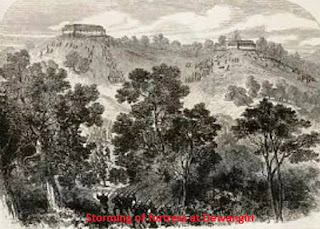Who was Dungsam Ja Drungpa?
Not even the name of Dungsam Ja Drungpa is known, forget about his life and family. The people who had some knowledge about Ja Drungpa are long dead, and sadly those histories are beyond retrieval. The present account of Dungsam Ja Drungpa has been derived from whatever the people could recount (Wangdi, S. nd).
Dungsam Ja Drungpa was from Khangma. This fact can be authenticated from the story between Ja Drungpa and Omniscient Khedrup Jigme Kundrel the founder of Yongla Gonpa. As per Sangchen Ogyen Tsukla Monastery (2016), Khangma Namgyal was the name of Dungsam Ja Drungpa who had the power to rule the east and south eastern province at that time. On request by the former to protect from one British invasion from the south, Jigme Kundrel prepared sadhana of Vajra Kilaya (Dorje Phurpa) according to Tantric tradition for seven days and did the Torjab towards the direction of invasion. That night a huge serpent appeared and destroyed almost all the invaders.
He lived with his wife, two sons, sister and a maid called Ja Zam. It seems that the people addressed him as Ja Drungpa, not by his actual name. He was appointed by Trongsa Penlop to collect taxes from Dungsam and Duar areas; so he was respected as much as he was feared. Taxes collected were deposited either directly to Trongsa Penlop or Zhongar Dzongpon.
There are folk songs dedicated to him and they are widely sung even today, like ‘Phu chi phu nyi….Dungsam Jadrung la shey shey’. There is no oral information on who preceded him as Ja Drungpa; but certainly no one succeeded him after his brutal death.
The Death of Ja Dungpa.
One account has it that there was a rising power of one man named Pel Thongley who arrived at Dungsam with large force and built a gigantic castle at the base of Lha Nang Zor in Pemagathsel. This instilled a sense of fear and respect amongst the people. Moreover, his sharp intelligence won over the leading figures and the people of Dungsam. This event naturally made Ja Drungpa envious of him. Later, Ja Drungpa came to know that Pel Thongley wanted to marry his sister. The former approached him and the marriage was accordingly arranged. But Ja Drungpa lied that his maid servant, Ja Zam was his sister and Thongley married Ja Zam. Ja Drungpa gave him a plot of land in Khangma as present. The actual intention of Ja Drungpa was to know Thongley’s weakness and then to overcome him.
One account has it that there was a rising power of one man named Pel Thongley who arrived at Dungsam with large force and built a gigantic castle at the base of Lha Nang Zor in Pemagathsel. This instilled a sense of fear and respect amongst the people. Moreover, his sharp intelligence won over the leading figures and the people of Dungsam. This event naturally made Ja Drungpa envious of him. Later, Ja Drungpa came to know that Pel Thongley wanted to marry his sister. The former approached him and the marriage was accordingly arranged. But Ja Drungpa lied that his maid servant, Ja Zam was his sister and Thongley married Ja Zam. Ja Drungpa gave him a plot of land in Khangma as present. The actual intention of Ja Drungpa was to know Thongley’s weakness and then to overcome him.
Slowly, Thongley came to know his wife’s identity before Ja Drungpa could achieve his plan. He took this as an insult, and the fight ensued between the two in which Ja Drungpa was brutally killed.
In a ‘dob’ (wooden bucket), Ja Dungpa’s wife collected blood of his husband, mixed it with water and splashed it over the land given to Thongley by her deceased husband. She cursed the land with extreme anger and hatred. She prayed that henceforth this particular land should not yield any harvest and that any family trying to cultivate it should meet the fate of her husband. Today, the people of Khangma call this land as monang sa, meaning the forsaken land.
compiled by Tenzin Deki Lhendup, Kurtoep, contact: 17407618
Reference
Wangdi, S., n.d. Myth, Legend and History Surrounding Dungsam. Page 21-23. Publisher: Journal of Bhutan Studies
Wangdi, S., n.d. Myth, Legend and History Surrounding Dungsam. Page 21-23. Publisher: Journal of Bhutan Studies


Comments
Post a Comment